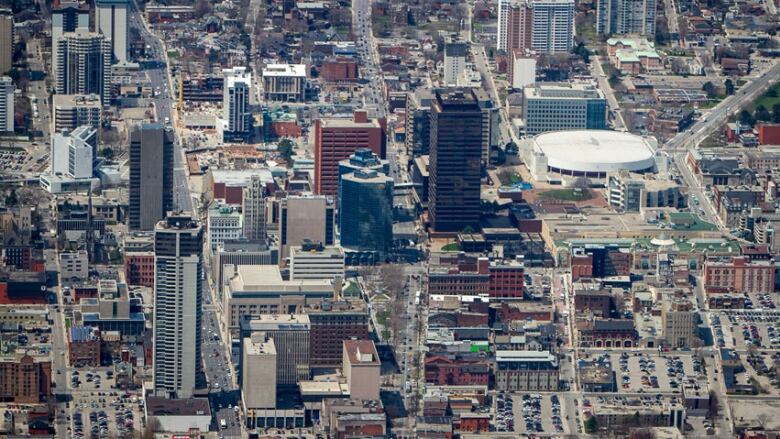Should developers still get city money to build downtown?
Level of private investment in Hamilton's core now hard to imagine 10 years ago

The city is reconsideringthe way it hands outtaxpayer money to private developers and business owners to foster urban renewal.
The review ofa range of incentive programscomes at a time of a booming housing market and a level ofprivate investment in Hamilton's core that was impossibleto imagine even 10 years ago.Thoseprogramsto keep downtown and business strips from crumbling further were conceived whenthe market and private banks had little interest in Hamilton.
As a city we're maturing to the point where we're getting enough interest that we can be more selective.- Glen Norton, Urban Renewal manager, City of Hamilton
The city has given out millions ingrants and loansto fixfacades,preserve heritage buildings and improve dilapidated buildingsthat haveadded up tomore than $300 million in investment across the city.
Now, the city is askingsomecontentious questions, as it tries to balance responsible spending of taxpayer dollars with helping private investorscontinueuplifting and renewingits downtown core, especially:
Who should get city help to build private projects?
Where should the boundary be drawn for where the free market will naturally invest in Hamilton?
Where it will not investwithout government help?
These questions and more will come up Tuesday at a public meeting to talk about the incentives. The discussion will hinge on the premise that Hamilton need no longer be grateful for a developer wanting to build anything.
"We're beyond that now,"said Glen Norton, head of the city's Urban Renewal team."We used to accept anything, too. As a city we're maturing to the point where we're getting enough interest that we can be more selective."
But many developers will tell stories of cajoling private construction lenders who aren't as convinced by Hamilton's recent renaissance. They say the programs need to stay if downtown's turnaround is to continue.
Ripple effect
The city is proud of the ripple effect of these incentives. In one program, the city granted $4.7 million in rebates on increased property taxes to developers and store owners who'd invested $104 million in improving their properties.
In another, the cityhas lent $33 million to residential developers who've dumped more than $200 million into their projects.
The city gave out more than 220 incentiveslast year alone, representing several million dollars in matching funds, forgivable grants or loans. Manyof them were small: An average grant of $14,716 multiplied over 32 improvement projects led to $1.25million in investments in improving BIAs last year.
"Things have certainly changed since 2010," Norton said."Where's the need the greatest geographically? For what type of development, what type of incentive?"
'One of the last areas to see some of the uplift'
The incentives that have come out of the plan include rehab help for dilapidated buildings and tired facades, heritage preservation grants, andlowered or waived development charges for new residential projects.
The incentivesare granteddowntown but also along business corridors, in Business Improvement Areas like Barton Village and Ottawa Street and in smaller communitydowntownslikeDundasandWaterdown.
The city's recently commissioned reports on its Barton andKenilworthbusiness corridors, for example, could play prominently into the next round of focusing its incentives.
Consultants on those reports found "it's probably one of the last areas to see some of the uplift" other parts of the city is seeing, Norton said.
'Incentives are required anywhere in the lower city'
For years, the downtown core writ large was seen as a place where the city needed to offer financial boosts to people willing to build something.
Now, home prices are rising quickly. A new GO station and LRT promise never-before-seen transit interconnectedness in the lower city. Downtown businesses and offices bring 25,000 workers to the core.
And 2014 was the first year when the value of residential construction projects downtown surpassed the value of non-residential projects.
But the downtown still needs a boost, according to developers like Jeff Paikin, the developer behind City Square condos in Durand.
He hasbeen public about his frustration with the city's boundaries for the benefits. His project is outside the downtown boundary outlined in the City Improvement Plan, and thus doesn't qualify for waived development fees and charges that can cost well into the thousands of dollars per unit. He's been appealing that decision and hopes the city will change its mind, which he says wouldallow him to build a planned third phase of his project.
It's too early to turn the city's focus from its downtown, he said. While land is considerably cheaper, the cost of labour and materials to build in downtown Hamilton rivals what developers pay in higher-priced cities like Toronto, he said.
"Incentives are required anywhere in the lower city," he said.
His experience is one example of how contentious just drawing the boundary for the programs can be.
"Approximately a year ago, we went to the city and said define downtown more accurately," Paikin said. "[The City Improvement Plan Area] issignificantly inaccurate as to what people would deem to be downtown."
The city's City Improvement Plan review meeting begins at 6 p.m. Tuesday at 40 Bay Street South. More information on the city's website.












_(720p).jpg)


 OFFICIAL HD MUSIC VIDEO.jpg)
.jpg)



























































































